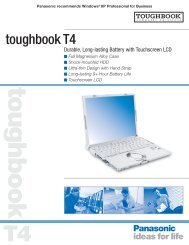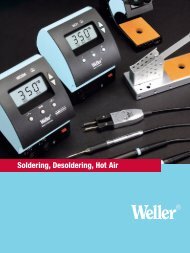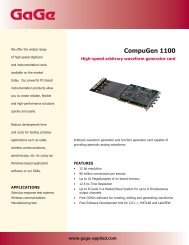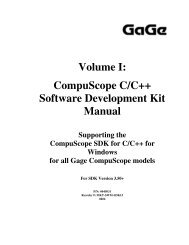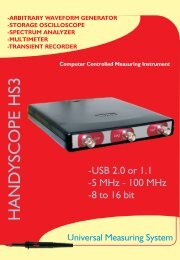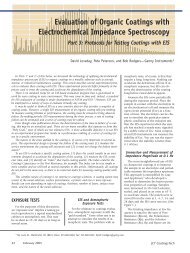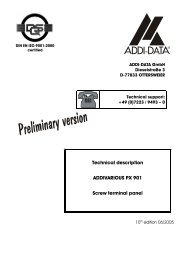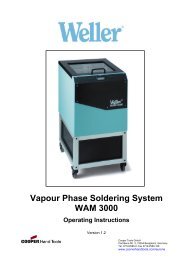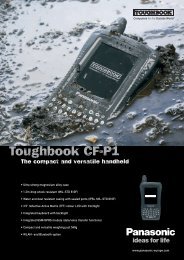CompuScope SDK Manua.. - Egmont Instruments
CompuScope SDK Manua.. - Egmont Instruments
CompuScope SDK Manua.. - Egmont Instruments
Create successful ePaper yourself
Turn your PDF publications into a flip-book with our unique Google optimized e-Paper software.
gage_transfer_buffer_3<br />
Syntax<br />
C:<br />
uInt32 GAGEAPI gage_transfer_buffer_3 (int32 ta, int16 channel, void far *buffer, int32 nsamples);<br />
Visual BASIC:<br />
Function gage_transfer_buffer_3 (ByVal ta As Long, ByVal channel As Integer, buffer As Integer, ByVal<br />
nsamples As Integer) As Integer<br />
Remarks<br />
gage_transfer_buffer_3 is used to copy nsamples points from the specified channel to the supplied<br />
buffer beginning from address ta. The channel can be either GAGE_CHAN_A or GAGE_CHAN_B. The<br />
relevant addresses can be obtained by calling gage_calculate_addresses. . The buffer must have been<br />
previously typecast to the appropriate size. For 8 bit <strong>CompuScope</strong>s, the buffer should typecast for uInt8<br />
values. For <strong>CompuScope</strong>s with more than 8 bit resolution, the buffer should typecast for int16 values.<br />
The <strong>CompuScope</strong> PCI boards will use PCI bus-mastering if available in hardware, otherwise a CPU<br />
mediated PCI data transfer method is used. PCI bus-mastering is the fastest possible PCI data transfer<br />
method.<br />
The buffer must be padded so that it is slightly longer than the memory required to store nsample samples.<br />
The required amount of padding is different for different <strong>CompuScope</strong> models. The best padding method<br />
is to use the variable user_buffer_padding, which is returned by the drivers and is the amount of extra<br />
padding in Bytes required for the current <strong>CompuScope</strong> model.. Simply add user_buffer_padding to the<br />
amount of memory to be allocated.<br />
Unlike gage_transfer_buffer, in single channel mode gage_transfer_buffer_3 automatically downloads<br />
data from both <strong>CompuScope</strong> A/D converter memories and internally interleaves them. Consequently,<br />
the user application does not need to interleave the data when the acquisition has been performed in<br />
single channel mode using gage_transfer_buffer_3. In single channel mode, gage_transfer_buffer_3<br />
need only be called once with channel equal to GAGE_CHAN_A<br />
Return Value<br />
Returns an offset from the beginning of the dword-aligned buffer that the driver uses.<br />
Internally using PCI bus-mastering, PCI <strong>CompuScope</strong> hardware can only transfer data from a d-word (4<br />
byte) boundary in <strong>CompuScope</strong> on-board memory. For instance, data can be downloaded starting from<br />
hexadecimal addresses 0x3000 or 3004, but not starting from hexadecimal addresses 0x3001.<br />
The returned offset gives the byte address location of the address ta, specified in the call to<br />
gage_transfer_buffer_3. For instance, if ta were equal to hex 0x3003, then the <strong>CompuScope</strong> would be<br />
forced to download data from hexadecimal addresses 0x3000. The offset would then be returned as<br />
0x3003 – 0x3000 = 3.<br />
See also: gage_transfer_buffer and Appendix: Comparison of Various Data Transfer Routines.<br />
Examples:<br />
<strong>CompuScope</strong> API Reference <strong>Manua</strong>l<br />
53



